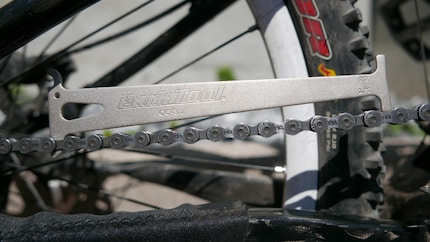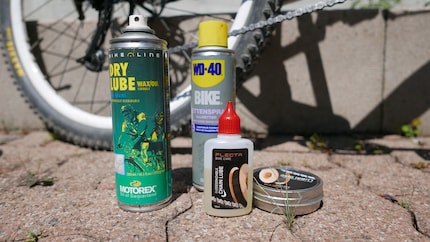

Quick guide to cleaning your bike chain
Dust, mud, moisture, salt – they all get stuck in the chain of your bike and can cause wear, poor shifting and rough pedalling. That’s why cleaning your bike chain regularly and replacing it in time is key.
Pedalling puts great pressure on every single link of your bike chain. Nevertheless, this ingenious construction is so robust that it’s been the chosen bicycle drivetrain system since the late 19th century. Belt drives are becoming more and more popular, but chances are the one you own has a chain. And if you haven't paid attention to it for a while, it’s about time you did.
Determining wear and tear
Over time, the connecting links wear out, causing the chain to stretch and eventually be unusable. It might skip over the cogs, stop gripping properly or even snap. In any case, the cogs and cassette may be damaged, resulting in expensive repair work. There are simple tools to measure for chain wear. They indicate how much the chain has stretched.

Cleaning the chain
Your chain is still OK? Good. To keep it that way, you should keep it clean. The less dirt clogs up your chain, the longer it will last. If you’re like me and cycle in any weather without cleaning it regularly, your bike’s chain will occasionally look like a black, sticky disaster area.
There are many ways and long descriptions of how to look after a bike chain. Some swear by the simple method of using a lint-free cloth and a few drops of WD-40. Others use the complete range including a chain cleaning device and special brushes. One thing is certain: you should keep your hands off strongly degreasing cleaning agents, as they wash out the protective layer between the chain links. You want to keep the grease, but get the dirt off before you put on new lubricant.
I use chain cleaner to soften up the dirt. I remove dirt that’s trapped in between the cogs with an allen key or screwdriver. To get rid of the last bits of dirt, I’ve made a special tool from two old attachments of my electric toothbrush and a pair of pliers. Of course, you can also stick two regular toothbrushes together and let the chain run through the brushes. Once the dirt is removed, rinse the chain with water and dry it with a lint-free cloth.

Applying lube
Once you’ve thoroughly cleaned and dried the chain, you need to apply a lubricating film. This keeps friction low and ensures that the chain slides over the teeth efficiently. A good lubricant reduces wear and prevents rust. At the same time, it needs to attract little dirt, spread optimally and be easy to use.
Dry lube evaporates, leaving a thin wax film on the chain. This film is dirt repellent and therefore great in dry, dusty conditions. However, it melts in rain and therefore has to be applied more frequently than a wet lubricant. Wet lube, on the other hand, magically attracts dust and dirt, but it protects better against moisture. If you enjoy cycling off-road, choose the lubricant according to the weather conditions. Experiment and you’ll find your own magic formula.
Who am I to judge – others have done so after carrying out extensive laboratory tests. Tests by Radfahren.de pronounced the F100 winner of «Best chain lube». The products by Muc-Off performed very well in terms of wear protection and lubrication effect.
Ceramic chain lubes are supposed to offer a little more longevity and longer maintenance intervals at a good price. They contain nanoparticles that minimise wear. Of course, there are also alleged all-weather oils and biodegradable lubricants, which are better from an environmental point of view. There’s not one perfect chain lube for all conditions. But you’ll do well to take regular care of your bike chain.

Spraying or dripping? As if there weren’t enough lubes to choose from, you also have a choice between spray lube and drip lube. Sprays are easy to use and spread well between the chain links. Yet, there’s a risk of it spreading to places it shouldn’t, such as the chainrings, brake discs or brake flanks. Oils are a bit more complicated to handle, but they can be applied with pinpoint accuracy. The best way to do this is to follow the motto: less is more.
It is about lubricating the joints of the chain links. You apply it drop by drop directly to the link on the inside of the chain, moving the chain backwards slowly at the same time. Make sure that the chain runs as straight as possible. Then remove excess lubricant with a dry cloth – or an old sock. If you’re using a wet lubricant and the outside of the chain is too oily, there will be a layer of dirt stuck to it within no time. Then you’ll have to start over again. Either way, the search for the «right» way to clean and look after your bike chain is a never-ending story and there are at least as many opinions as there are lubricants. The main thing is that you remember to do it regularly!
Simple writer and dad of two who likes to be on the move, wading through everyday family life. Juggling several balls, I'll occasionally drop one. It could be a ball, or a remark. Or both.
Practical solutions for everyday problems with technology, household hacks and much more.
Show all




